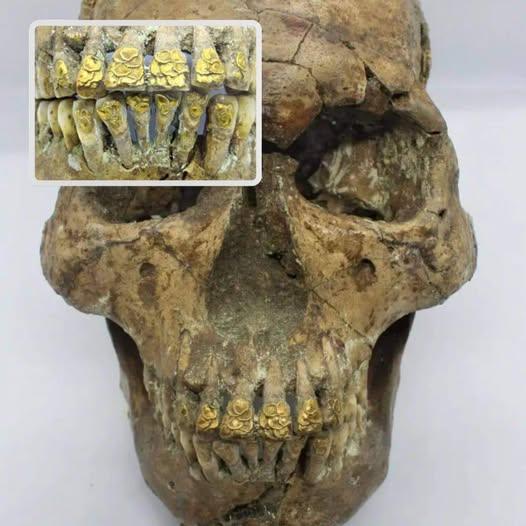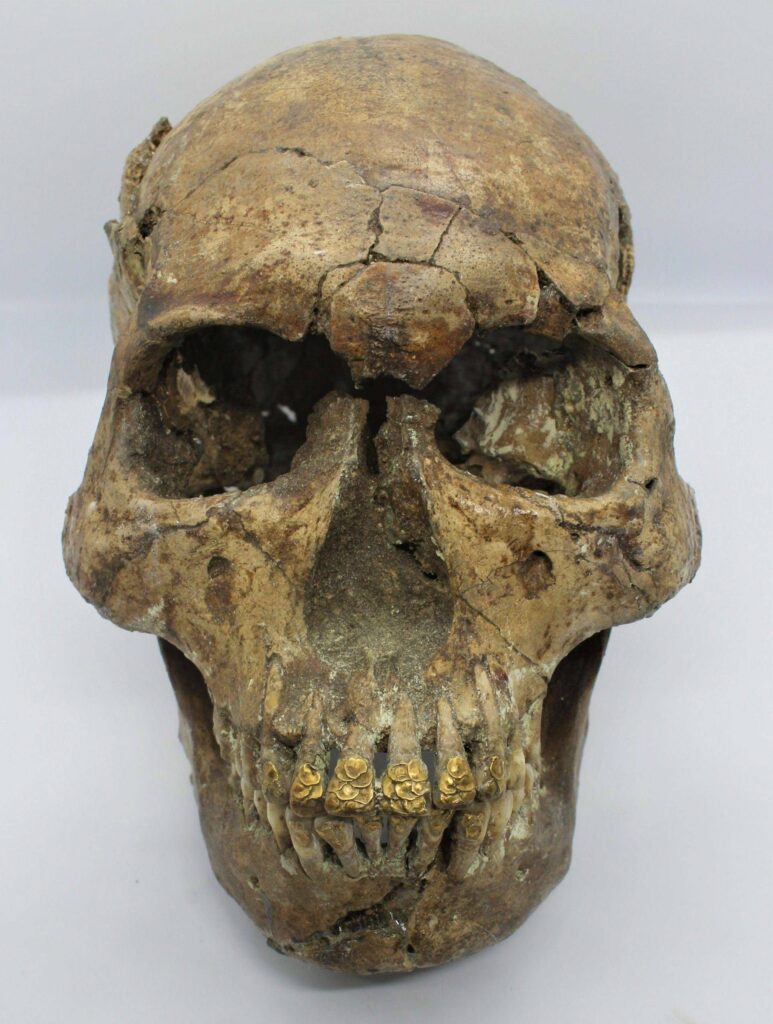The Bolinao Skull: A Golden Smile from Ancient Philippines

In the coastal town of Bolinao, Pangasinan, Philippines, an extraordinary archaeological find—the Bolinao Skull—has captivated researchers and enthusiasts alike. Discovered at the Balingasay Archaeological Site, this ancient human skull, dating to the 14th–15th century CE, is renowned for its intricate gold dental adornments resembling fish scales, a testament to the advanced metallurgy and cultural sophistication of pre-colonial Filipino societies. With its pronounced forehead and lack of a prominent brow ridge, the skull may link to early Austronesian peoples, offering insights into their migration, trade, and artistry. This 2000-word, SEO-optimized article explores the Bolinao Skull’s discovery, significance, and cultural context, while drawing parallels to other remarkable finds like the Prehistoric Snuggle, Egtved Girl, Saqqara cat sarcophagus, Muhammad and Samir, and the “Follow Me” sandals.
The Discovery: Unearthing a Golden Treasure
The Bolinao Skull was excavated at the Balingasay Archaeological Site near the Balingasay River in Bolinao, Pangasinan, during systematic digs led by the National Museum of the Philippines in 1964, though earlier explorations occurred in the 1920s and 1940s. The site, dated to the 14th–15th century CE, yielded 67 skulls, 51 adult burials, and two infant jar burials, alongside trade ceramics from China’s Early Ming Dynasty (1368–1644 CE). The Bolinao Skull (GR 37), declared a National Cultural Treasure in 2010, stands out for its complete set of teeth adorned with gold scales on the buccal surfaces of the upper and lower incisors and canines, secured with gold wire rivets.
The skull’s dental ornaments, measuring about 10 mm wide by 11.5 mm high, were crafted by drilling holes into the teeth and inserting gold disks, plugs, or wires, creating a fish-scale pattern. This intricate work, likely painful, suggests a high level of skill and cultural significance. The presence of Ming ceramics indicates robust trade networks, connecting the Philippines to East Asia during the proto-Age of Trade. The skull, now displayed at the Pang-ulo Exhibit on the 4th floor of the National Museum of Anthropology in Manila, continues to reveal secrets about pre-colonial Filipino life.
Historical Context: Pre-Colonial Philippines and Austronesian Peoples

The Bolinao Skull dates to the protohistoric period (9th–16th century CE), when the Philippines was a network of maritime polities engaged in trade with China, Thailand, and Southeast Asia. The archipelago, known as “Suvarnadvipa” (Islands of Gold), was rich in gold, fostering wealth and craftsmanship. The Balingasay site, near the mouth of the Balingasay River, was likely a coastal trading hub, evidenced by the Ming ceramics and gold artifacts.
The skull’s morphology—a pronounced forehead and minimal brow ridge—suggests a possible link to early Austronesian peoples, who migrated across the Indo-Pacific from southern China and Taiwan around 4,000–5,000 years ago. These seafarers, ancestors of modern Filipinos, brought advanced maritime technology, agriculture, and cultural practices, including metallurgy.
Dental ornamentation was widespread in the Philippines before Spanish colonization in 1521. Practices included staining teeth red or black with plant dyes, filing, and gold-pegging, with gold symbolizing prestige and beauty. Eight of the 51 adult burials at Balingasay had gold-decorated teeth, and four showed staining or filing, suggesting these were markers of status or identity. The Bolinao Skull’s owner, possibly a high-ranking individual, reflects the social stratification of these communities.
Cultural Significance: Gold Teeth and Social Status

The Bolinao Skull’s gold dental adornments are a masterpiece of pre-colonial artistry, revealing key cultural practices:
-
Metallurgical Skill: The fish-scale ornaments, crafted with gold plates and rivets, demonstrate advanced goldworking techniques. Holes drilled into teeth required precision tools, like the ulok (awl), and expertise, indicating specialized artisans.
-
Social Symbolism: Gold teeth were a status symbol, signifying wealth, bravery, or elite status. The elaborate design suggests the owner was a respected figure, possibly a leader or noble.
-
Aesthetic Ideals: Dental modification, including gold pegging and staining, was a beauty standard, akin to head-shaping or ear-piercing in other Philippine cultures. The fish-scale pattern may have held symbolic meaning, perhaps tied to marine motifs common in Austronesian art.
-
Trade Networks: The presence of Ming ceramics alongside the skulls points to trade with China, suggesting Bolinao was a node in regional commerce, exchanging gold, pearls, or beeswax for luxury goods.
These insights portray a vibrant, stratified society with sophisticated craftsmanship and global connections, challenging stereotypes of pre-colonial Philippines as isolated or primitive.
Scientific Significance: Decoding the Skull
The Bolinao Skull has been studied using modern archaeological methods, though some analyses remain ongoing:
-
Radiocarbon Dating: The skull and associated ceramics date to the 14th–15th century CE, confirmed by Ming Dynasty artifacts.
-
Morphological Analysis: The pronounced forehead and reduced brow ridge align with Austronesian cranial traits, supporting theories of their migration to the Philippines. Further osteological studies could clarify age, sex, and health, though initial reports suggest an adult, possibly male.
-
Material Analysis: The gold ornaments, likely pure or alloyed, were examined for craftsmanship. The fish-scale design, unique to Bolinao, differs from simpler gold pegging found in Samar or Cebu, indicating regional variation.
-
Contextual Study: The Balingasay site’s 67 skulls, with eight featuring gold teeth, suggest a cemetery for an elite group. Flooding and erosion posed excavation challenges, but the site’s proximity to the river supports its role as a trade hub.
Future DNA analysis could confirm Austronesian ancestry, while facial reconstruction might visualize the skull’s owner, offering a tangible connection to the past, as proposed by researchers.
Comparisons to Other Archaeological and Historical Finds
The Bolinao Skull shares thematic and cultural parallels with other narratives, highlighting human ingenuity and identity:
-
Prehistoric Snuggle (South Africa, 250 MYA): The Broomistega–Thrinaxodon fossil, preserved in a burrow, captures a moment of coexistence, like the Bolinao Skull’s snapshot of cultural artistry. Both reflect resilience—surviving the Great Dying or thriving in a trade-rich Philippines.
-
Egtved Girl (Denmark, 1370 BCE): The Egtved Girl’s preserved textiles, like the Bolinao Skull’s gold teeth, signify status and craftsmanship. Both reveal personal adornment as a cultural marker, linking individuals to their societies.
-
Saqqara Cat Sarcophagus (Egypt, Late Period): The mummified cat, a sacred offering, parallels the Bolinao Skull’s symbolic adornments. Both reflect reverence—spiritual for the cat, social for the skull—expressed through material culture.
-
Muhammad and Samir (Damascus, 1889): Their interdependent friendship mirrors the Bolinao Skull’s evidence of community collaboration, where artisans and elites worked together to create gold ornaments, transcending individual roles.
-
“Follow Me” Sandals (Ancient Greece): The sandals’ imprinted messages parallel the Bolinao Skull’s gold teeth as bold expressions of identity. Both used material objects to communicate—advertising for prostitutes, status for Filipinos.
These comparisons underscore the universal human drive to express identity, whether through survival, adornment, or communication.
Cultural Impact and Modern Resonance
The Bolinao Skull, declared a National Cultural Treasure, has sparked fascination in the Philippines and beyond. Displayed at the National Museum of Anthropology, it draws visitors eager to see its “golden smile.” On X, hashtags like #BolinaoSkull and #PhilippineHistory trend, with users sharing images and pride in pre-colonial heritage. The skull has inspired art, jewelry designs, and documentaries, celebrating Filipino craftsmanship.
Its modern appeal lies in its defiance of colonial narratives, showcasing a sophisticated pre-Spanish culture. It resonates with Filipinos reclaiming their heritage, much like the “Follow Me” sandals empower ancient Greek women’s stories. The skull also informs discussions about Austronesian migrations, connecting the Philippines to a broader Pacific narrative.
Engaging with the Bolinao Skull
Visit the National Museum of Anthropology in Manila to see the Bolinao Skull at the Pang-ulo Exhibit. Search #BolinaoSkull on X for discussions and fan content. Read Bolinao: A 14th–15th Century Burial Site by Avelino Legaspi for scholarly insights, or watch NMP’s “Tawir Talks” series. Create art or jewelry inspired by the fish-scale design to join the conversation about Filipino heritage.
Strengths and Weaknesses of the Narrative
Strengths
-
Cultural Insight: The skull reveals pre-colonial artistry, trade, and social hierarchy, enriching Philippine history.
-
Scientific Value: Its context and morphology support Austronesian migration theories, with potential for further DNA analysis.
-
Public Appeal: The gold teeth captivate audiences, fostering pride in Filipino heritage.
-
Preservation: The skull’s condition and associated artifacts provide a robust dataset for study.
Weaknesses
-
Limited Biological Data: Partial skeletal remains limit insights into the individual’s life, unlike the Siberian foal’s DNA.
-
Excavation Challenges: Flooding and local resistance hindered comprehensive site analysis, leaving gaps in context.
-
Speculative Identity: The owner’s exact role (leader, warrior) remains uncertain, relying on contextual clues.
What Secrets Does the Bolinao Skull Reveal?
The Bolinao Skull unveils several secrets about pre-colonial Philippines:
-
Advanced Metallurgy: The fish-scale gold ornaments showcase skilled goldworking, predating Spanish influence.
-
Social Stratification: Gold teeth suggest elite status, reflecting a hierarchical society.
-
Trade Networks: Ming ceramics indicate global commerce, linking Bolinao to East Asia.
-
Austronesian Heritage: The skull’s morphology ties to early migrations, connecting Filipinos to Pacific peoples.
These insights reveal a sophisticated, interconnected society, where artistry and status were intertwined.
Why the Bolinao Skull Matters
The Bolinao Skull is a shining emblem of Filipino heritage, proving that pre-colonial societies were far from primitive. Its gold teeth, like the Egtved Girl’s skirt or the Prehistoric Snuggle’s burrow, tell a story of human ingenuity and identity. As a National Cultural Treasure, it inspires pride and curiosity, inviting us to explore our shared past.
For fans of archaeology, it offers a tangible link to Austronesian history, while its “golden smile” captivates imaginations. It reminds us that beauty, status, and connection are timeless human pursuits.
How to Engage with the Bolinao Skull
Visit the National Museum in Manila or explore virtual tours online. Search #BolinaoSkull on X for discussions and art. Read Philippine Studies or Antonio Pigafetta’s 1521 accounts for historical context. Share your thoughts in forums or create designs inspired by the skull to celebrate Filipino culture.
Final Thoughts
The Bolinao Skull, with its golden fish-scale teeth, is a radiant artifact of pre-colonial Philippines, illuminating the artistry, status, and trade of its time. Likely belonging to an Austronesian elite, it connects the past to the present, showcasing a society as vibrant as its gold. Like the Prehistoric Snuggle or Muhammad and Samir’s bond, it tells a story of resilience and connection, preserved for us to marvel at.
What secrets does this skull reveal? It shows us a world where beauty was crafted in gold, status was worn proudly, and trade spanned oceans. So, what does the Bolinao Skull inspire in you? Share your thoughts and let its golden smile light the way.